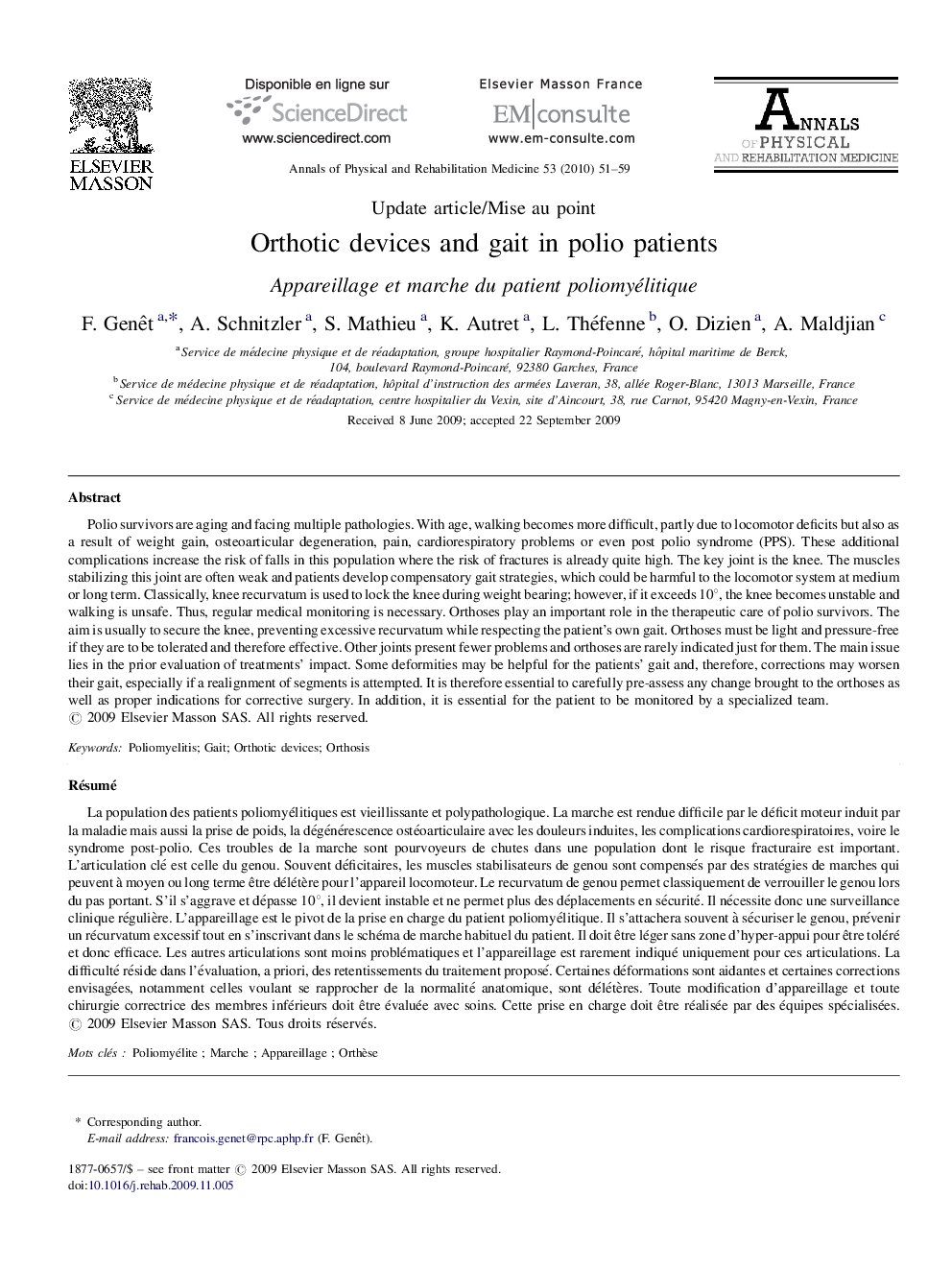| کد مقاله | کد نشریه | سال انتشار | مقاله انگلیسی | نسخه تمام متن |
|---|---|---|---|---|
| 4041520 | 1603350 | 2010 | 9 صفحه PDF | دانلود رایگان |

Polio survivors are aging and facing multiple pathologies. With age, walking becomes more difficult, partly due to locomotor deficits but also as a result of weight gain, osteoarticular degeneration, pain, cardiorespiratory problems or even post polio syndrome (PPS). These additional complications increase the risk of falls in this population where the risk of fractures is already quite high. The key joint is the knee. The muscles stabilizing this joint are often weak and patients develop compensatory gait strategies, which could be harmful to the locomotor system at medium or long term. Classically, knee recurvatum is used to lock the knee during weight bearing; however, if it exceeds 10°, the knee becomes unstable and walking is unsafe. Thus, regular medical monitoring is necessary. Orthoses play an important role in the therapeutic care of polio survivors. The aim is usually to secure the knee, preventing excessive recurvatum while respecting the patient's own gait. Orthoses must be light and pressure-free if they are to be tolerated and therefore effective. Other joints present fewer problems and orthoses are rarely indicated just for them. The main issue lies in the prior evaluation of treatments’ impact. Some deformities may be helpful for the patients’ gait and, therefore, corrections may worsen their gait, especially if a realignment of segments is attempted. It is therefore essential to carefully pre-assess any change brought to the orthoses as well as proper indications for corrective surgery. In addition, it is essential for the patient to be monitored by a specialized team.
RésuméLa population des patients poliomyélitiques est vieillissante et polypathologique. La marche est rendue difficile par le déficit moteur induit par la maladie mais aussi la prise de poids, la dégénérescence ostéoarticulaire avec les douleurs induites, les complications cardiorespiratoires, voire le syndrome post-polio. Ces troubles de la marche sont pourvoyeurs de chutes dans une population dont le risque fracturaire est important. L’articulation clé est celle du genou. Souvent déficitaires, les muscles stabilisateurs de genou sont compensés par des stratégies de marches qui peuvent à moyen ou long terme être délétère pour l’appareil locomoteur. Le recurvatum de genou permet classiquement de verrouiller le genou lors du pas portant. S’il s’aggrave et dépasse 10°, il devient instable et ne permet plus des déplacements en sécurité. Il nécessite donc une surveillance clinique régulière. L’appareillage est le pivot de la prise en charge du patient poliomyélitique. Il s’attachera souvent à sécuriser le genou, prévenir un récurvatum excessif tout en s’inscrivant dans le schéma de marche habituel du patient. Il doit être léger sans zone d’hyper-appui pour être toléré et donc efficace. Les autres articulations sont moins problématiques et l’appareillage est rarement indiqué uniquement pour ces articulations. La difficulté réside dans l’évaluation, a priori, des retentissements du traitement proposé. Certaines déformations sont aidantes et certaines corrections envisagées, notamment celles voulant se rapprocher de la normalité anatomique, sont délétères. Toute modification d’appareillage et toute chirurgie correctrice des membres inférieurs doit être évaluée avec soins. Cette prise en charge doit être réalisée par des équipes spécialisées.
Journal: Annals of Physical and Rehabilitation Medicine - Volume 53, Issue 1, February 2010, Pages 51–59